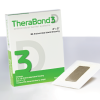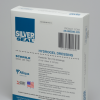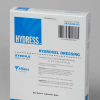About Hydrogels
Hydrogels are gel-like or colloidal substances made of water and solids. They can be created chemically (through a combination of ultra violet cross-linking and chemical interface), or by mixing polymer and water, and then exposing it to an electron beam creating a “sheet” of water. Alliqua believes that its hydrogels have a competitive advantage, in part due to the following product characteristics: painless adhesion to the human body, stability of form and composition, purity, reproducibility (manufacturing high quality product on a consistent basis), compatibility with active ingredients, and high water content.
Many of the products of Alliqua’s competition feature physical characteristics which Alliqua believes are less desirable than its own hydrogels. These include aggressive skin bonding, chemical and form instability, lack of uniformity, low water content, odor and active receptivity issues.
Applications
Applications for Alliqua’s hydrogel products include:
- Transdermal drug delivery
- Wound care
- Components for medical devices
- Cosmetic patches and masks
- Conductive and non-conductive adhesives
- Temperature management
- Medical diagnostics
Alliqua’s Langhorne, PA Facility
Alliqua Hydrogels
We provide custom manufacturing solutions to partners in the medical device and cosmetics industry, utilizing our proprietary hydrogel technology. The electron beam production process, located at our 16,000 square foot GMP manufacturing facility in Langhorne, PA, allows us to develop and custom manufacture a wide variety of hydrogels. Hydrogels can be customized for various transdermal applications to address market opportunities in the treatment of wounds as well as the delivery of numerous drugs or other agents for pharmaceutical and cosmetic industries.
Our hydrogels are manufactured by introducing a hydrophilic polymer, which is a polymer that has a tendency to mix with or dissolve in water, into water to create a feed mix. The feed mix is then coated on to a liner and exposed to radiation. The polymers we use, when exposed to radiation, cross link faster than they degrade, creating a matrix that gives the gels a solid form.
Active ingredients such as prescription or over-the-counter medication, skin care ingredients or wound-healing or other materials can be added before or after cross-linking. Materials that do not survive the irradiation process, or are modified by such process, are added after the cross-linking process is completed.
Once the products have been mixed and cross-linked, they form sheets that can either be delivered directly to customers or first cut and shaped according to customer or our specifications, as appropriate. We believe that many of the processes described above are proprietary to us and provide us with competitive advantages, including our production of a high quality product and our increased ability to customize products for customers.
Advantages
Our electron-beam cross-linking process is one of three types of cross-linking used in the industry. The other types used are ultra violet cross-linking and chemical cross-linking. We believe that the benefits of electron beam cross-linking include:
- Allows for precise control of the amount of polymer cross-linking.
- Obviates the need for chemical cross-linking agents which may complicate or interfere with other additives or active ingredients.
- Provides the ability to manufacture high quality hydrogels on a consistent basis.
The cross-linking of hydrogels can be further modified by varying the percent of polymer cross-linking and the way in which the high energy field is delivered. There are three variables in the use of an electron beam accelerator for cross-linking of hydrogels:
- Time of exposure of the target material to the electron stream.
- Voltage (electrical potential).
- Amperage (strength of the electrical current).
Proprietary Processes
Many of the products of Alliqua’s competition feature physical characteristics which Alliqua believes are less desirable than its own hydrogels. These include aggressive skin bonding, chemical and form instability, lack of uniformity, low water content, odor and active receptivity issues.
Mixing
We believe that we are able to manufacture hydrogel feed mixes with far greater homogeneity than those of our competition. This manufacturing advantage is critical, especially as it relates to dosages of active ingredients. In addition, our proprietary mixing technology allows for the incorporation of sensitive materials that may degrade if subjected to other types of mixing.
Coating
Our proprietary coating technology enables us to properly coat the gels even though the gels are extremely thick and resistant to flow. We have achieved coating tolerances that have allowed us to coat materials as thin as 0.005 of an inch with a margin for error of typically less than 5%. Thickness controls are critical with respect to the performance of many of the end products utilizing our hydrogels, including medical electrodes, transdermal delivery patches and cosmetic patches.
Cross-linking
We cross-link our hydrogels using an electron beam accelerator. Such linking is achieved by introducing a high energy field, created by accelerated electrons, which causes the release of hydrogen atoms and causes carbon molecule covalent bonding. The creation of longer chains of the polymer in the gel increases its molecular integrity, giving the gel characteristics that make it useful in a variety of products.







